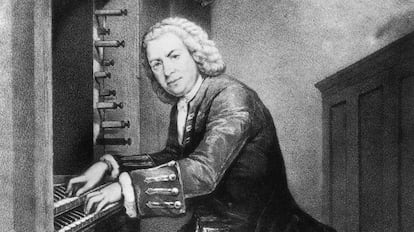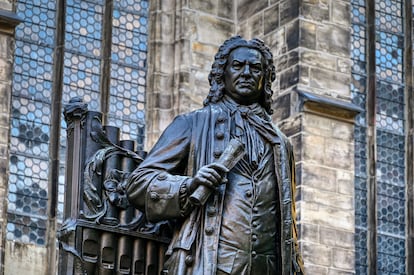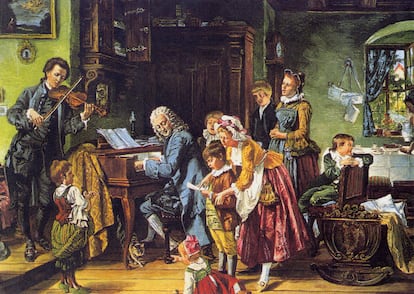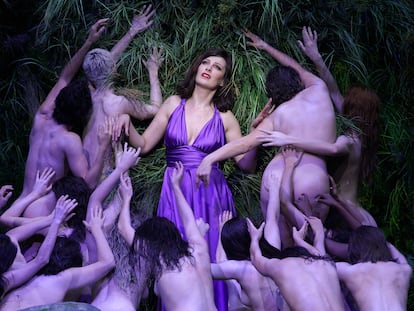The endless legacy of Johann Sebastian Bach
As the creator of over a thousand works, the German musician still has tremendous influence today, and every Easter his ‘Passions’ can be heard in concerts all over the world

When the youngest child of the town musician Johann Ambrosius Bach and his wife Elisabetha was born in Eisenach, Germany, 339 years ago on March 21, 1685, no one could have imagined the importance that this new life would have in the history of Western music. That child, Johann Sebastian Bach, was born into a very large musical family that would inundate several generations of cultural life (Bach in German means “stream”). He would be, and still is today, the most influential composer in the long history of music from the 17th century to today. Every Easter, his Passions can be heard in concerts all over the world in a musical liturgy that goes beyond the Protestant religion in which the composition was conceived.
Today, Bach is the musician whose work remains most relevant to us, for example, in teaching this art. Johann Sebastian Bach’s own education had its light and darkness. In those years, the surname Bach in Germany was synonymous with musician. Many organists, singers, chapel masters and musical directors belonged to the Bach family. And they were all taught by fathers, cousins, brothers or uncles, which facilitated learning from an early age. Bach himself was trained by his father and older brother. The latter, however, was the one who cast certain shadows on the education of his younger brother by preventing him from accessing a precious notebook with works by other great musicians. But little Johann Sebastian sneakily copied that music at night in order to have access to the scores of the great masters of his time. For his part, Bach devoted great effort to creating works for the education of his children and students.

The Well-Tempered Clavier, the French Suites, the Organ Book and Inventions are all works intended for educational purposes, primarily for his eldest son Wilhelm Friedemann, but also for the pupils he taught in Leipzig. Written in the early years of the 18th century, these books now form part of the curricula of all conservatories around the world. They help students learn the organ, harpsichord and piano, and also serve for analyzing and studying harmony, counterpoint and composition. If Suites for Solo Cello, Partitas for Solo Violin and the Sonatas for Viola da Gamba are also taken into account, Bach’s teaching spectrum widens even more. No other composer has such a strong presence in the training of our future musicians.
Waht’s more, Bach was a very prolific composer. More than a 1,000 cataloged works cover an enormous variety of genres — religious and secular cantatas, motets, masses, oratorios, passions, magnificat and chorales in vocal music. He also composed about 500 pieces for keyboard, divided evenly between the organ and the harpsichord. His instrumental and chamber music was also abundant. He wrote concertos for soloists and orchestras and purely orchestral pages. In the speculative field, he created two fundamental works, The Art of the Fugue and The Musical Offering, in which he demonstrates his enormous contemporary mastery of making contrapuntal, melodic and harmonic juggling, which has never been surpassed.
Bach knew how to combine the Italian and French styles in vogue in Europe with the Germanic tradition of Schütz, Scheidt and Buxtehude. Incidentally, he made a nearly 400-kilometer (248.5 miles) pilgrimage on foot to Lübeck to listen to the latter.
Musical architecture
All this knowledge allowed him to build his music on very solid foundations, musical architecture that confers consistency and formal balance on each and every one of his compositions, however simple or brief they may be. Bach’s work has a singular quality that has allowed his music to be approached from radically different perspectives, always successfully, from transcriptions for (sometimes picturesque) instruments, such as the accordion, the hurdy-gurdy and the pan flute, to their successful manipulation by the great masters of jazz, including John Lewis, the Modern Jazz Quartet and the Jacques Loussier Trio.
Bach’s music fills auditoriums, concert halls, churches and festivals thanks to the excellent historically rigorous interpretations that we have been able to enjoy for decades. Great musicians have become models of his music: Harnoncourt, Pinnock, Herreweghe, Gardiner and Suzuki for the most important works, and Glenn Gould, Marie-Claire Alain, Gustav Leonhardt, András Schiff and Benjamin Alard for his keyboard pieces. In addition, there’s the marvelous rediscovery of Bach’s Cello Suites by their discoverer, Pau Casals, as well as modern visions brimming with purity by Yo-Yo Ma and Jean-Guihen Queyras.

Today, Bach is also very present in other arts. Choreographers such as George Balanchine, Paul Taylor and Benjamin Millepied have poured the genius of Eisenach’s most diverse creations into the art of dance.
Cinema has also made use of Bach’s music in hundreds of films. Surely Bach never could have suspected that his compositions for specific characters such as the Margrave of Brandenburg, Count Keyserlingk, or his patron, Prince Leopold of Anhald-Cöthen, would be used in an art form that he could not even imagine. To give just a few examples, Bach appears in films such as Andréi Tarkovsky’s Solaris, Jonathan Demme’s The Silence of the Lambs and Steven Spielberg’s Schindler’s List. But perhaps the work with the greatest importance is Saraband, Ingmar Bergman’s last film and his cinematic legacy. In it, Sarabande from the Suite for Solo Cello No. 5 in C Minor BWV 1011 takes center stage to such an extent that it gives the film its title.
Bach is also commonly found on social media, websites, blogs and radio stations. For years, Radio France’s France Musique and RTVE’s Radio Clásica (Classic Radio) have maintained weekly programs dedicated to the German master’s music, such as Le Bach du dimanche and Bach Hour, which the author of this article directed until last February.
Indirectly, we are also indebted to Bach for the ability to attend public concerts. The Café Zimmermann in Leipzig — where Bach and his children and students at the Collegium Musicum offered weekly concerts — was one of the first spaces for open access to music. It was no longer only churches and palace halls where that pleasure could be enjoyed. Any artisan, merchant or law student could attend a concert and see Bach conducting one of his works.
Bach is even present on the surface of the planet Mercury. There is a perfectly circular, double-crowned impact crater that has borne the composer’s name since 1976. In addition, Bach’s music is currently traveling outside the solar system, as it is installed on the Golden Records on the Voyager spacecrafts, which contain key references of life on our planet.
Since the 17th century, scholars of nature have said that nightingales who placed their territory near a fountain or a stream sang more and better. Their life was fuller. Let us learn from these birds and live near a stream, near Bach. Our existence will be a happier one.
Sign up for our weekly newsletter to get more English-language news coverage from EL PAÍS USA Edition









































